Xin Wang - PowerPoint PPT Presentation
1 / 13
Title:
Xin Wang
Description:
9/15/09. 3. The needs of Next Generation Service Providers ... 9/15/09. 8. Reality: leased bandwidth price has not been dropping consistently and dramatically. ... – PowerPoint PPT presentation
Number of Views:37
Avg rating:3.0/5.0
Title: Xin Wang
1
Resource Negotiation, Pricing and QoS
for Adaptive Multimedia Applications
- Xin Wang
- With Henning Schulzrinne
- Internet Real -Time Laboratory
- Columbia University
- http//www.cs.columbia
.edu/xinwang/RNAP.html
2
Todays IP Networks
Service Level Agreements (SLA) are negotiated
based on Application Specific Needs bandwidth,
loss, delay, jitter, availability, price
ISP Networks
Applications
IP Network
Service
User
SCOPE
- Growth of new IP services and applications with
different bandwidth and quality of service
requirements - Presents opportunities and challenges for service
providers
3
The needs of Next Generation Service
Providers
- Revenue from the traditional connectivity
services (raw bandwidth) is declining - Increase revenue by offering innovative IP
services - Deliever high-margin, differentiated services
- VoIP, VPN, Applications Hosting etc
- Gain competitive advantage by deploying new
services more quickly, placing a premium on time
to market and time to scale - Reduce cost and operation complexity
- Evolve from static network management to dynamic
service provisioning - Reduce costs by automating network and service
management
4
Internet Structure
5
NORDUnet Traffic Analysis
6
NORDUnet Traffic Analysis
- Results
- All access links (interconnect ISPs or connect
private networks to ISPs), including
trans-Atlantic links, can get congested. - Average utilization is low 20-30
- Peak utilization can be high up to 100
- Congestion Ratio (peak/average) as high as 5.
- Peak duration can be very long
- Chicago NAP congested once in 8/00, lasted 7
hours. - TeleGlobe links congested every workday in 8/00
and 9/00 - Reasons Frequent re-configuration and
upgradingLoad balancing to protect own users.
7
Solution - Over-provisioning?
- Add enough bandwidth for all applications in
access network / backbone - Will over-provisioning be sufficient to avoid
congestion? - How much bandwidth is enough to meet diverse user
requirements? - No intrinsic upper limit on bandwidth use
- How much does it cost to add capacity?
8
Bandwidth Pricing
- Reality leased bandwidth price has not been
dropping consistently and dramatically. - Facts
- 300 mile T1 price (rent)
- 1987 10,000/month
- 1992 4,000/month
- 1998 6,000/month (thanks to high Internet
demand) - 100-mile cabling cost in 1998 65,000
- Links connecting ISPs are very expensive
9
Bandwidth Pricing (cont.)
- Facts
- International Frame Relay with 256-kbps
thousands dollars a month. - Transit DS-3 link 50,000/month between
carriers. - Transit OC-3 link 150,000/month between
carriers. - Chicago NAP
- 3,900/month/DS-3,
- 4,700/month/OC-3.
Bandwidth may be cheap, but not free Higher-speed
connection -- higher recurring monthly
costs. Option - manage the existing bandwidth
better, with a service model which uses bandwidth
efficiently.
10
Solution - Other Service Models
- Quality of Service (QoS)
- Condition the network to provide predictability
to an application even during high user demand - Provide multiple levels of QoS to meet diverse
user requirements - How efficient a QoS mechanism manages the
bandwidth? How much a user needs to pay for QoS? - Application adaptation
- Source rate adaptation based on network
conditions can avoid congestion and lead to
efficient bandwidth utilization - Why would an application adapt?
11
A more Efficient Service Model
- Dynamic resource negotiation
- Network commits resources for short intervals -
better response to changes in network conditions
and user demand - Usage-,QoS-,demand-sensitive pricing
- Allow network to price services based on
resources consumed, and allocate resources
based on user willingness-to-pay - Give user incentive to select appropriate service
based on requirements, adapt demand during
network resource scarce in response to price
increase
12
What We Add to Enable This Model?
- A dynamic resource negotiation protocol RNAP
- An abstract Resource Negotiation And Pricing
protocol - Enables user and network (or two network domains)
to dynamically negotiate multiple services with
different QoS characteristics - Enables network to formulate and communicate
prices and charges - Lightweight and flexible embedded in other
protocols, e.g., RSVP, or implemented
independently - Ensures service predictabilitycommit service and
price for an interval - Supports multi-party negotiation senders,
receivers, or both - Reliable and scalable
- A demand-sensitive pricing model
- Enables differential charging for supporting
multiple levels of services services priced to
reflect the cost and long-term user demand - Allows for congestion pricing to motivate user
adaptation
13
What we add... (contd)
- Demonstrate a complete resource negotiation
framework (RNAP, pricing model, user adaptation)
on test-bed network - Simulations show significant advantages relative
to static resource allocation and fixed pricing - Much lower service blocking rate under resource
contention - Service assurances under large or bursty offered
loads, without high provision complexity, or
over-provision cost - Higher perceived user benefit and higher network
revenue































